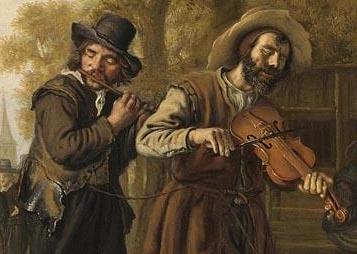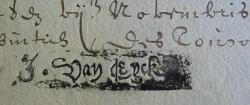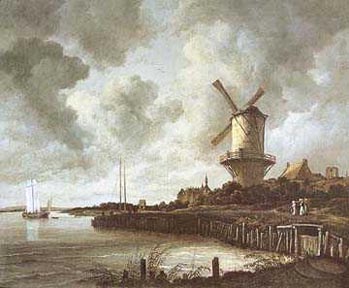|
A
genuine signature of Jacob van Eyck
Jacob van
Eyck was blind at birth, so his job opportunities were limited. He lived
in a world without Braille. Being musically gifted was a blessing under
the circumstances. Dutch organists and carillonneurs mainly improvised,
which could be done without eyes. Memorizing a tune and combining this
with musical imagination and instrumental skills was sufficient for
those who wanted to play variations. Van Eyck was by no means the only
blind professional musician in the Dutch Republic. Another celebrity
was Pieter de Vois, the organist of the Sint-Jacobskerk in The Hague,
a star pupil of Jan Pieterszoon Sweelinck. And let us not forget the
poor wretches who went from door to door to earn some money making music.
A moving painting (1652) of Jan Victors shows a blind duo playing the
violin and transverse flute, guided by a dog and assisted by a woman
with a collection box in her hand and a child on her back. (Illustration
1)
 |
|
Illustration
1
Jan Victors
1619—c1676
The blind fiddler (1652), detail
(click on the image for the full painting) |
| |
|
|
Because
of his blindness, Van Eyck never learned to write. The nobleman had
a rather distinguished way of signing official documents: he used a
name stamp. In the city archives of Heusden (where he spent his early
years) and Utrecht, many examples can be found on receipts. (Illustration
2) Four times a year he received his salary. Two surviving letters -
one written to Constantijn Huygens, the other to the organist Lucas
van Lenninck in Deventer - were dictated. They show the handwriting
of someone else.
Illustration
2
Van Eyck's name stamp, under a receipt.
Heusden, Streekarchief, E211 |
|
 |
| |
|
|
Nevertheless,
an autograph signature survives, due to the fact that Van Eyck forgot
to take the stamp with him during a trip in 1621. He still lived with
his mother in Heusden.
 |
|
On
16 September of that year, he was in Wijk bij Duurstede, a small
town 15 miles southeast of Utrecht, situated on the bank of the
river Rhine. Wijk bij Duurstede gained worldwide renown through
the mill which Jacob van Ruysdael painted in 1670. (Illustration
3) (The present mill is not the same one, by the way.) Business
brought Van Eyck there. He was about to receive a yearly interest
from church goods, a so-called 'vicarie', being granted to him by
no less a person than the Stadholder Prince Maurits. |
Illustration
3 Jacob van Ruysdael,
The mill at Wijk bij Duurstede (1670) |
|
Van Eyck
had been nominated in vain for such an interest twice before, the first
time in 1603. I guess, it was meant by Prince Maurits as a kind of orphan's
allowance. Van Eyck's father had occupied an important position in the
Dutch army. He died in 1604, probably during the siege of Ostend in
Flanders. The 'vicarie' would amount to 110 guilders a year.
Van Eyck
went to Wijk bij Duurstede in order to authorize the stewart and secretary
of the local chapter. When he appeared before the notary without his
name stamp, he had to sign the document by hand. He produced a cross,
the usual sign for people who were unable to write. (Illustration
4)

Illustration
4 Van Eyck's signature
Wijk bij Duurstede, Streekarchief,
Notarieel Archief, inv.no. 2941, fol. 21
Afterwards,
the notary wrote around it: "Dit is tmerc van Jo.r Jacob van Eyck"
('This is the sign of Jr. Jacob van Eyck'). It is probably the sole
surviving autograph of the blind master…
Thiemo
Wind
|